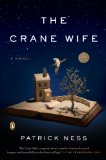Page 1 of 1
There is 1 reader review for The Crane Wife
Write your own review!
 Cloggie Downunder
Quite magical.
Cloggie Downunder
Quite magical.
“…a story …is a net, a net through which the truth flows. The net catches some of the truth, but not all, never all, only enough so that we can live with the extraordinary without it killing us”
The Crane Wife is the third stand-alone novel by American author, journalist and lecturer, Patrick Ness. He takes the old Japanese folktale of the same title and gives it a modern twist. George Duncan, a forty-eight-year-old divorced American living in London, goes outside on a cold winter’s night to find a crane with an arrow through its wing. He manages to remove the arrow, the crane flies off, and by the next day he is unsure it wasn’t all a dream. In his print shop the next day, he is toying half-heartedly with his latest artistic hobby, cuttings from discarded paperbacks mounted onto black backgrounds, when a woman comes in, introduces herself as Kumiko, and changes his life.
George’s adult daughter, Amanda is divorced from Henri, the father of her young son, JP (Jean Pierre) and, despite a loving upbringing, has difficulty maintaining close relationships, parents and son excepted. Her latest friendships with work colleagues, Rachel and Mei, seem to be disintegrating before her eyes. Amanda is stunned by the speed at which her father’s courtship of Kumiko progresses until she meets this remarkable woman herself.
This is a wonderful tale featuring quirky yet appealing characters and filled with beautiful prose: “…it was one of those special corners of what’s real, one of those moments, only a handful of which he could recall throughout his lifetime, where the world dwindled down to almost no one, where it seemed to pause just for him, so that he could, for a moment, be seized into life” and “The books on George’s walls were his sand mandala….they were the most serene reflection of his internal state. Or if not quite his internal state, then at least the internal state he would like to have had” and “…it was nothing at all like those hunched, purplish grey birds he sometimes saw skulking around the city like unwashed old gentlemen” are but a few examples.
Ness gives his characters plenty of words of wisdom: “…the inability of people to see themselves clearly. To see what they are actually like, not what they fear they are like or what they wish to be like, but what they actually are. Why is what you are never enough for you?” and explores the nature of truth and stories: “There were many truths – overlapping, stewed together – as there were tellers. The truth mattered less than the story’s life. A story forgotten died. A story remembered not only lived, but grew”
“He would tell her story. Not her whole story, of course, but the story of him and her, the story he knew, which were the only stories anyone could ever really tell. It would be only a glimpse, from one set of eyes” And what a superb story it is. Quite magical.
